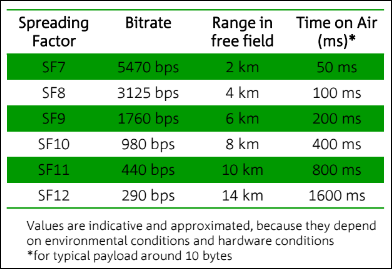Coverage
KPN designs it’s network to have SF10 or better outdoor in The Netherlands, where KPN includes presence of buildings and other important objects. Walls and buildings typically reduce a signal by 2 SFs, creating a typical value of SF12 indoor in The Netherlands. Actual indoor coverage largely depends on type of building material, rule of thumb should be “you should have LoRa coverage when you see (reflected) daylight”. Note however that certain kinds of window coatings can also have a significant blocking effect on radio signals.
Time on Air
An important consequence of using a higher spreading factor for LoRa is a longer time on air (ToA). The LoRa Radio module needs more time to send the same amount of data. This ranges from 50 ms for a 10 byte payload on SF7 to a ToA of 1600 ms for the same packet on SF12. This means that power consumption increases with increasing Spreading Factor. To optimize spreading factor, Adaptive Data Rate ADR should be used.








